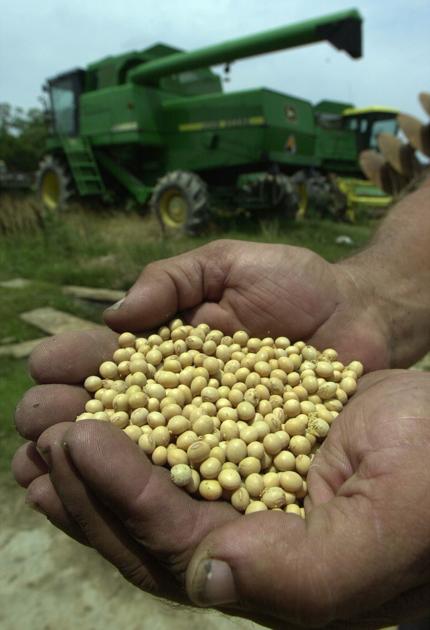
Soybean farmers are cautiously optimistic about this year’s crop, thanks to steadily increasing prices and a worldwide increase in demand that is triggering more activity at export facilities.
“The price is great right now, but we’ve still got to produce a crop,” said Donald Schexnayder, who grows about 3,000 acres of soybeans and corn on his farm in Erwinville. “We’re a long way from home.”
After dipping to $8.66 a bushel in August, the price for the grain has steadily gone up. As of early last week, soybeans were just below $14 a bushel, the highest price they’ve been in nearly seven years.
Prices have gone up due to rising demand in China, after a trade war with the U.S. cooled off last year and the Trump administration got the country to agree to buy more soybeans from American farmers.
“They’re following through and buying a lot of soybeans and corn,” said Schexnayder, the Louisiana Farm Bureau chairman for soybean, wheat, feed and grains.
Also helping to boost grain sales in China is the fact that the country is trying to build back its hog population after an outbreak of swine fever ravaged the industry, said Michael Deliberto, an economist with the LSU AgCenter.
“Producers are cautiously optimistic about this year compared to last year,” he said.
Adding to the good feeling is the fact that while soybean prices have risen dramatically in the past seven months, the cost of producing a crop will be at or below where it was last year. The coronavirus pandemic has kept natural gas prices steady, meaning its use as a raw material for fertilizer has the kept the cost down.
Louisiana farmers get a slightly higher price for their soybeans because of the fact they don't have to ship the crop far to get it to south Louisiana ports, Deliberto said.
David Moseley, the LSU AgCenter’s soybean specialist, said in 2020, 1.02 million acres of soybeans were planted in Louisiana. That’s up from about 850,000 acres in 2019. The number is expected to go up even more.
“Going forth this year, I’ve heard some producers say they’re going to plant acres that were not in soybean rotation for the past three to five years,” he said. “The price drives most of those decisions.”
While the majority of the soybean crop in Louisiana is grown in the central and northeastern part of the state, the plants can be found all over. For the most part, it is rotated with corn, although in some parts of south Louisiana soybeans rotate with sugar cane and rice.
One indicator of how many acres could be planted is from 2014, the last time soybean prices were in the $14-a-bushel range, there were about 1.3 million acres of the crop statewide. Moseley said he’s seen projections that 90 million acres of soybeans may be planted in the U.S. this year, up from 83 million in 2020.
In anticipation of the bigger soybean crop, Cargill said it is spending $475 million to improve its processing plants in seven Midwestern states.
Much of the soybeans and other crops grown in the Midwest make their way down the Mississippi River by barge to commercial facilities and to south Louisiana ports for export. A 2017 LSU AgCenter report noted that soybeans accounted for over half the volume of agricultural exports going through Louisiana.
Soybeans last year accounted for a 21% share of total agricultural and nonagricultural Louisiana exports, up from a 12.8% share in 2019 that was down from being at 18.7% in 2017.
Louis Dreyfus, which operates the grain elevator at the Port of Greater Baton Rouge, isn’t making any investments directly tied to the soybean demand and rising prices. However, the company has taken steps over the past 18 months to increase the unloading capacity for grain at the port, said Kimberly Hawks, a commercial manager for Dreyfus’ eastern supply chain. That’s cut in half the amount of time it takes trucks to unload at the elevator.
Dreyfus and the port are working together on a $7 million project to put a crane on a barge. That will make it easier to unload grain in times when the level of the Mississippi River is high or low.
“It was almost painful to watch offloading happen a couple of years ago, when the river was so high for months,” said Jay Hardman, the port’s executive director. A contract for the crane on barge was recently signed and it should take about 14-18 months to complete the work, Hardman said.
Greenfield Louisiana LLC, of Baton Rouge, wants to build a 36-silo grain terminal on the west bank of St. John the Baptist Parish. It says the 248-acre export terminal would employ 60 people in barge, dock, rail, truck, storage, processing and elevator operations for wheat, corn and soybeans. Last May, the Port of South Louisiana applied for a $25 million federal grant to help it build a dock for Greenfield’s terminal. If approved by the U.S. Department of Transportation, the port would lease the dock to Greenfield.
Some residents, and the ACLU of Louisiana, object that Greenfield's operations and grain dust emissions would threaten the health and safety of neighbors.
"about" - Google News
April 04, 2021 at 12:15PM
https://ift.tt/3rMfwk4
High prices lead to optimism about Louisiana's soybean crop - The Advocate
"about" - Google News
https://ift.tt/2MjBJUT
Bagikan Berita Ini














0 Response to "High prices lead to optimism about Louisiana's soybean crop - The Advocate"
Post a Comment